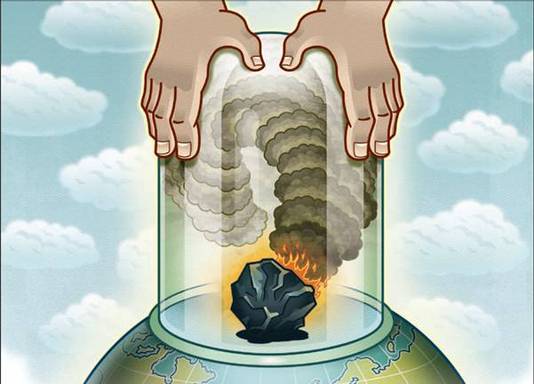 Eight years on since the United Nations IPCC was awarded the Nobel Peace Prize in recognition of its effort in combating climate change, fossil fuel remains the most dominant global energy source. As the total replacement of fossil fuel burning is not expected to take place immediately in the near future, the International Energy Agency (IEA) has repeatedly declared carbon capture and sequestration (CCS) as a key technology for mitigating climate change.[1] Although CCS is envisioned to play critical role in the fight against climate change, why have these technologies not had an international breakthrough? And what needs to be done for it to happen? From an economic perspective, there are 3 major barriers for CCS technology development. The first arises from the competition from non-fossil based energy carriers including renewables and nuclear. The second concerns the maturity of the CCS technology. The last is related to the cost of capture and storage. Let us first consider the competition from other energy carriers. Wind and solar, when coupled with storage technologies to tackle intermittency issue, allow power generation without the emission of greenhouse gases. The same is true for nuclear energy but its public acceptance has been on decline following the Fukushima Daiichi nuclear disaster. Therefore, wind and solar are considered the most serious competitor with the CCS-mitigated fossil fuel. However, the formers’ high costs compared to the fossil fuel render unlikely threats to the use of CCS. Turning to the degree of maturity of the CCS technology, one has to recall that CCS has three major components: (CO2) capture, transportation (of CO2 in a liquid-like state) and geological storage. Although these three components are in commercial use, their integration and the scaling up of CCS is yet to be seen. The Saskpower’s Boundary Dam CCS project in Saskatchewan, Canada, has been plagued with numerous shutdowns that cost CAD$1.2 million (HKD 7 million) in penalties. Similarly, the CCS facility in Mississippi Power’s Kemper County lignite plant has been struggling with delays, most recently, related to the ash removal system.[2] From these examples, it is evident that the CCS technology has been facing first-of-its-kind risks to costs. The last barrier, that is, the cost of CCS, is apparent. A lower cost of CCS per ton CO2 will make it more economically feasible. Yet, according to the report of the Office of the Canadian Parliamentary Budget Officer (see p 40), the cost for the Boundary Dam CCS project has come in at CAD$ 917 million (HKD 5.32 billion) — it was originally budgeted to cost CAD$800 million (HKD 4.64 billion). Putting together estimates of revenues and expenditures, the project is expected to generate a loss of CAD$ 1 billion (HKD 5.8 billion).[3] In order to overcome these barriers, two factors stand out. The first one concerns the carbon policy. The second one is an improved technology that would allow for a successful integration the three major components at a lower cost. Carbon policy is imperative for CCS. Unless CO2 emissions are taxed, a coal-fired power plant will have no incentives for using CCS. It will simply release CO2 into the atmosphere. The same applies if the emission tax is lower than the cost of CCS. It has been estimated that emission tax of CAD$ 57 (HKD 331) per ton CO2 will be necessary to motivate a power plant to undertake a CCS project. To improve the technology, an important component is learning-by-doing (LbD). LbD is simply productivity gains through production practice, minor innovations, and specialization. Saskpower stated that LbD can reduce costs by approximately CAD$200 million (HKD 1.16 billion) on its ongoing CCS activities. In this case, a CAD$47 (HKD 273) per ton CO2 carbon tax will allow the power company to undertake a CCS project. With the growing number of CCS projects, it is only a matter of time before all the technological drawbacks are properly addressed. Thus, to have CCS, what remains to be seen is a credible carbon policy that can allow investors to undertake CCS projects. This will be crucial in building a global CCS industry to deal with fossil fuels as the dominant energy source in the coming decades. Tunç Durmaz and Aude Pommeret (SEE, CityU Hong Kong) [1] https://sequestration.mit.edu/bibliography/ccs-crossroads.pdf [2] It is estimated that any extension of the in-service date past Feb. 28 can add around $30 million a month to the total cost of the project. [3] There are also new costs that have been coming out of the operational side of CCS. As an example, the cost of amine, an ammonia derivative used to clean particles of CO2 from exhaust, is much higher than anticipated for Sask Power due to the solvent being degraded much more quickly than expected. The cost of amine, which was budgeted for CAD$5 million per year, is now budgeted for CAD$20 million. See http://www.cbc.ca/news/canada/saskatchewan/saskpower-carbon-capture-1.3896487 Paragraph. Düzenlemek için buraya tıklayın.  With a one-way ticket towards a more carbon constrained world, it is important to conjecture the future composition of energy generation and the roles assigned to different technologies. One technology in this regard that is highly credited by International Energy Agency (IEA) within the future energy mix is carbon capture and storage (CCS). However, without proper carbon markets and a sufficiently high carbon price, this technology may not play its desired role. Besides, even with well functioning carbon markets, technological investments (R&D) may be directed to renewable energy and related technologies. First of all, considering CCS, one will be investing in a technology that depends on the use of fossil fuels, which are exhaustible in nature. Secondly, one will be investing in a technology that will paradoxically extend the life of fossil-fuel energy use, which we might want to avoid. However, as it seems, the dependence on fossil-fuels will not cease in the decades to come. Given that global warming is a real phenomenon with possibly catastrophic consequences, CCS may very well fit into the picture. The Norwegian moon landing project may thus be quite to the point. That said, Norwegian public resources that sum up to NOK 14 billion in 2016, before having captured and stored a gram of CO2, it is crucial to incorporate the economic perspective into the picture. If you imagine the alternative use of the 14 billion, it will be easier to see how the economics can be important. NHH Professor Fred Schroyen and PhD candidate Tunç Durmaz, in a new NHH working paper, evaluate the scope for CCS in the future. In doing this they assume that a final good called energy is produced via fossil-fuels and renewables, which are close substitutes. An R&D sector can invest in technological change in three areas: CCS, fossil-fuels and renewable energy. Thus the four-sector general equilibrium model: has two sectors producing the final good called energy, a CCS sector, and an R&D sector.[1] They then look for the optimal taxation of the fossil-fuel energy industry, and the resulting energy mix, R&D distribution and levels for CCS for a time horizon of 300 years. In doing this analysis, they also introduce a climate module into the model such that it can mimic global warming that worsens with the rise in CO2 in the atmosphere (i.e. temperature rise). The rise in CO2 due to the use of fossil-fuel energy results in forgone environmental amenities and forgone production. The results have been somewhat surprising. Even with scenario for CCS with relatively low costs (60$ per ton of CO2) the future energy mix is composed of almost 100% of renewables. Then, with 0% fossil-fuels, there is also 0% CCS). The socially optimal solution necessitates a departure from the use of fossil fuels, and this also directs R&D investments, the cost of producing renewables become relatively low, and thus substitution away from fossil-fuels results. In order to have a future scenario with an active CCS sector that also attracts R&D investments, they calculated that its cost should be 80% lower than the benchmark level of 60$/tCO2. Also, if global warming is worse than expected, the scope for CCS narrows down, since then the switch from fossil fuels must happen earlier and with a faster pace. Looking at the results, it may not be unreasonable to ask why 7.3 billion NOK was spent to build the Technology Center Mongstad (which is an hour drive from Bergen). Why invest so much in a technology that may not be made use of in the decades to come? Well, the answer is not that obvious. It may perhaps be excessively optimistic that renewables expand in the way projected in the model, either because subsidies do not flow as easily, or because costs do not respond that well to R&D in renewables, or because renewables may not actually be expandable to the extent that they can account for such a big part in the energy-mix. For example, for hydroelectricity one cannot outlaw the geographical constraints. For biofuels, it is evident that they are competing for lands that can also be used for food generation. For several renewables, their intermittent nature is an issue, perhaps limiting the share they can take. In such cases, the authorities may find it more rational to impose limits on the carbon emissions in certain industries that can give the right incentives for and spur the development of CCS. Besides, countries that depend on big fossil-fuel economies and at the same time are relatively more concerned about climate change, for example Norway, can be more motivated to reduce the burden these sectors puts on the environment through CCS. To conclude, although the study limits the role for CCS, it bases this on certain model assumptions and a globally optimal solution and path. Other solutions may come about when one considers setups that do not rely on global optimization, or when other key assumptions are revised can perhaps project more of a role CCS. As the literature in this area is limited, more research is necessary. With the additional efforts put in this direction, various institutions and governments will be more confident in their decision to fund (or not) the CCS technology in the fight against climate change. This way, businesses will also see a clearer picture of the likelihood of the profitability of investments they will make in this respect. [1] For example a technical change in CCS technology means incurring less cost of capturing and storing CO2. References Tunç Durmaz and Fred Schroyen, Evaluating Carbon Capture and Storage in a Climate Model with Directed Technical Change, NHH Department of Economics Discussion Paper No. 14/2013 Strand, T. (2013) 'Forhandler om Mongstad', Bergens Tidende, 18 September, p. 8 -- You can view this post also @Reconhub The global energy consumption is heavily dependent on the energy generated from fossil-fuels. Although there are efforts to curb CO2 emissions by means of expanding the capacity for the renewable energy, we see that it is hardly enough to cover the rising energy demand. Hence the fossil-fuel generation seems to be anchored, stubborn to go down. One way out of this can be the Carbon Capture and Storage (CCS) technology, and Norway is the leading country in this respect (although the Boundary Dam Integrated CCS project in Canada is planned to be completed and able to commence the capture and storage of carbon by November, 2013). Hence, thinking that CCS is a viable option, we wanted to analyze the optimality of the technology in a global perspective, and decided to do this in the presence of technological change. In other words, in doing this we allowed for research and development decisions regarding the fossil-fuel energy, renewable energy and CCS technologies. Well, the results have come as a little surprise. I have attached the abstract below. For the interested reader, here is the link for the paper:
Evaluating Carbon Capture andStorage in a Climate Model with Directed Technical Change Abstract: Carbon capture and storage (CCS) is considered a critical technology needed to curb CO2 emissions and is envisioned by the International Energy Agency (IEA) as an integral part of least-cost greenhouse gas mitigation policy. In this paper, we assess the extent to which CCS and R&D in CCS technology are indeed part of a socially efficient solution to the problem of climate change. For this purpose, we extend the intertemporal model of climate and directed technical change developed by Acemoglu et al. (2012, American Economic Review, 102(1): 131{66) to include a sector responsible for CCS. Surprisingly, even for an optimistic cost estimate available for CCS ($60/ton of CO2 avoided), we find that it is not optimal to deploy CCS or devote resources to R&D in CCS technology either in the near or distant future. Indeed, it is only when the marginal cost of CCS is less than $12/ton that a scenario with an active CCS sector (including R&D) becomes optimal, though not in the near future. -- You can view this post also @Reconhub Strong wind flows causing high generation of electricity by windfarms may not always desirable when the price of electricity is taken into account. This widely known trade-off between price and output naturally pushes investors to consider portfolios of wind farms located in distant geographies.
Related to this, I discussed a paper by Richard Green and Iain Staffell “How Large Should a Portfolio of Wind Farms Be?”at the Conference on The Economics of Energy Markets organized by Toulouse School of Economics between Jan 17-18, 2013. The paper models the performance of –not-yet-established– wind farms in the UK for 2012-2020. The main focus is to exhibit the potential benefits of spreading windmills over a large area. They make use of a full market model and conjecture the revenues and the costs of 32,767 postfolios of wind farms. They argue that from the point of making an investment, measuring expected annual profits and their variance can give the most relavant information for investors. Following this, the authors calculate the efficiencies of these portfolios based on the distance between an efficiency frontier (a frontier built by the portfolios where it is impossible to raise the expected profits and at the same time reduce the variance) and an optimal portfolio, which has the highest profit and lowest variance (see the figure). The best of these portfolios can be observed to the south-east of the figure, which are the ones that give the highest mean annual profits and the lowest deviations. Their results show that optimal portfolios are contained in no more than 4 regions (see the table), suggesting that the benefits of having a portfolio of windfarms is an attainable target until 2020. One assumption in the analysis is that the cheapest available stations are assumed to be always available, meaning that they will be capable of meeting any demand. Hence in case you are an investor, you should not be worried about things like first movers since these sites will always be capable of supplying the land and others the investment would require. I find this assumption rather debatable, especially when a longer period of time is considered. Suppose the most profitable portfolios are taken and hence no more available. This will naturally result in a north-west shift in the efficiency frontier. What will happen for sure after the shift is that the investors will be left with optimal portfolios that would contain a higher number of sites, possibly making it quite difficult to attain the most profitable portfolios. This may imply that the time period after 2020 could be quite rough for investors. Hence, it will be quite interesting to see some dynamics in the analysis. As building a full market model to assess the portfolios is a bit of a challenge, the authors ask also whether it would be sufficient to assess only the expected annual output and its variance. To find an answer, they look at the correlation between the two measures (efficiency scores) and find that it is only 0.103 (see the figure). This is to say that the most profitable portfolios will not likely to be the ones that would be most productive. This may make the crowd go wild and favor the measure based on the profits, but maybe we should not be so fast in arriving this conclusion. Since the optimal portfolio analysis coming out of the full market model is based on many details, this strongly necessities a careful sensitivity analysis (The sensitivity of the results is mentioned by the authors as well. However, why there is no sensitivity analysis is a mystery). All in all, portfolio efficiency measured by profits make things easier from an investor’s point of view. However, to be confident about this, it is crucial to know and show that the results are not sensitive to some crucial details, which most possible have the tendency to variate in time. Lastly, incorporating dynamics, areal limitations and some strategic behavior into the analysis will take it a step further and make things even more interesting, though not less challenging. -- You can view this post also @Reconhub |
Archives
March 2021
Categories
All
Categories
All
Tunç DurmazI am an associate professor at the Department of Economics at Yıldız Technical University, İstanbul. |
| "In the end, our society will be defined not only by what we create, but by what we refuse to destroy" J. C. Sawhill |
|


 RSS Feed
RSS Feed
